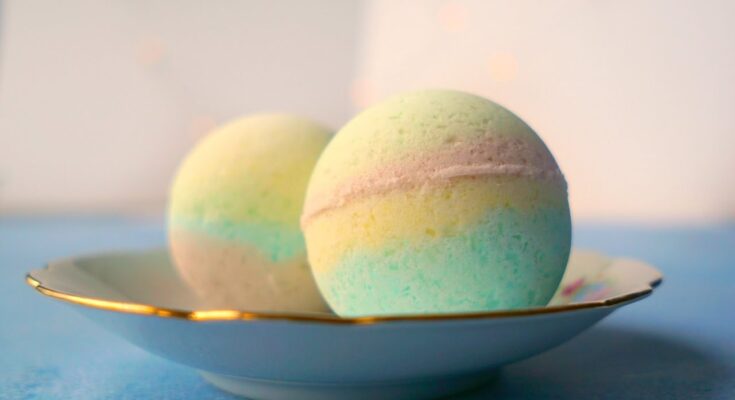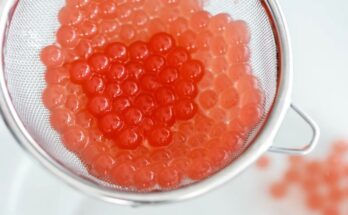Bath Bomb Recipe: Ever dropped a fizzy, colorful ball into your bath and watched it swirl and bubble into a magical spa-like experience? That’s the charm of a bath bomb! These tiny spheres of bliss are packed with nourishing ingredients, fragrant oils, and vibrant colors, all designed to turn a regular bath into a luxurious treat. Whether you’re into self-care Sundays, making handmade gifts, or just love DIY projects, learning how to make bath bombs is a fun, rewarding skill.
Bath bombs are incredibly popular thanks to their sensory appeal—imagine soothing aromas, skin-softening oils, and an Instagram-worthy bath. But buying them regularly can get pricey. The good news? You can make them at home easily, using simple ingredients and your creativity. Let’s dive in!
Benefits of Using Bath Bombs
You might think bath bombs are just for fun (and they totally are), but they come with some awesome benefits too:
1. Relaxation and Stress Relief
The fizzing action of a bath bomb releases essential oils and calming scents like lavender, eucalyptus, or chamomile. These aromas help to ease your mind and body after a long, tiring day.
2. Skin Nourishment and Moisturization
Most bath bombs are made with baking soda and citric acid, which soften the water. Add moisturizing oils like coconut, almond, or shea butter, and your skin gets a nourishing treat while you soak.
3. Aromatherapy Perks
Depending on the essential oils you use, your bath bomb can help boost your mood, clear your sinuses, or even help you sleep better. It’s a blend of beauty and wellness in one fizzy bomb!
Basic Ingredients Needed
To start making bath bombs, you’ll need a handful of basic ingredients that are easy to find either online or at your local grocery or health store.
Here’s a simple list:
- Baking Soda (1 cup): The primary fizzing agent.
- Citric Acid (1/2 cup): Reacts with baking soda for the fizz.
- Cornstarch (1/2 cup): Helps to bind and slow down the fizz.
- Epsom Salt (1/2 cup): Soothes muscles and detoxifies.
- Essential Oils (10-15 drops): For scent and aromatherapy.
- Carrier Oil (2.5 tbsp – e.g., coconut, olive, almond): Moisturizes your skin.
- Water or Witch Hazel (1 tsp): Helps hold the mix together.
- Colorant (optional): Mica powder or food coloring for fun colors.
These are the building blocks of every great bath bomb. Once you’ve got the hang of the basics, you can play with extras like dried flowers, glitter, or multi-color layers.
Tools and Equipment
You don’t need fancy equipment to make bath bombs, but having the right tools makes the job way easier:
- Mixing bowls (2-3): For wet and dry ingredients separately.
- Measuring cups and spoons: Precision matters.
- Spray bottle: To add water evenly without over-saturating.
- Whisk or spoon: For mixing.
- Bath bomb molds: These can be metal, plastic, or silicone. Even muffin tins work in a pinch.
- Gloves (optional): Keep your hands clean, especially with colors.
You can grab most of these tools from your kitchen or a dollar store. Once you’re stocked up, you’re ready to create your own fizz-tastic masterpieces!
Step-by-Step Bath Bomb Recipe
Let’s roll up our sleeves and get into the fun part: making bath bombs from scratch. Follow these detailed steps and you’ll be a pro in no time.
Step 1: Gather Your Ingredients
Measure out each ingredient before you start. This helps avoid mistakes and makes the mixing process smoother. Place your dry ingredients in one bowl and wet ingredients in another. This setup is crucial for the perfect blend.
Step 2: Mix the Dry Ingredients
In a large mixing bowl, combine:
- 1 cup baking soda
- 1/2 cup citric acid
- 1/2 cup Epsom salt
- 1/2 cup cornstarch
Use a whisk to thoroughly combine them. No clumps allowed! This ensures an even fizz and a smooth finish.
Step 3: Combine Wet Ingredients
In a separate small bowl, mix together:
- 2.5 tbsp coconut or almond oil
- 10–15 drops of your favorite essential oil
- A few drops of liquid color (if using)
Stir gently. Then slowly pour this into a spray bottle or prepare to drizzle it very carefully.
Step 4: Slowly Mix Wet into Dry
Now comes the tricky part. Add your wet mix very slowly into the dry mix—preferably by spraying or drizzling while constantly whisking. If you dump it all at once, it’ll start fizzing right away, and you don’t want that yet!
Keep mixing until the texture resembles slightly damp sand. If it clumps when squeezed, it’s perfect.
Step 5: Add Color and Fragrance
If you haven’t added your color or fragrance yet, now’s the time. Divide the mixture into sections if you want different colors. Use mica powder for vibrant hues or food-safe dye for soft pastels. Mix well so there are no streaks.
Step 6: Molding the Bath Bombs
Scoop the mixture into your bath bomb mold, slightly overfilling each half. Press them together tightly, then gently remove the mold after a few seconds. Be careful—they’re fragile at this stage.
If you’re using silicone molds, press the mix firmly and let them dry inside the mold.
Step 7: Let Them Dry Properly
Place your bath bombs on parchment paper or a towel. Let them dry at room temperature for 24–48 hours. Don’t rush this part—they need time to harden fully.
Once dry, store them in an airtight container in a cool, dry place.
Common Mistakes to Avoid
Even though making bath bombs is fun and fairly simple, there are a few mistakes that can totally ruin your fizzing masterpiece. Don’t worry, though—once you know what to avoid, you’ll be creating pro-level bombs every time.
1. Adding Too Much Liquid
One of the biggest slip-ups? Going overboard with the wet ingredients. When you add too much liquid—especially water—it can activate the fizzing reaction before you even mold the bomb. That means you’ll end up with a crumbly mess instead of a firm, fizzy bomb.
To fix this, always add liquids slowly and in small amounts. Use a spray bottle when adding water or witch hazel. It helps distribute moisture evenly without overdoing it.
2. Not Mixing Well Enough
Uneven mixing means some parts of your bath bomb might not fizz properly, or the color and scent could be patchy. Be patient and mix thoroughly after each step. Take your time to get that dry-sand texture just right.
3. Unmolding Too Soon
Bath bombs are delicate right after you mold them. If you try to remove them too quickly or handle them roughly, they’ll crumble. Always let them sit in the mold for a few minutes to firm up before releasing. And after unmolding? Let them dry completely—at least 24 hours—for best results.
4. Skipping Citric Acid
Some people try to leave out citric acid, thinking it’s optional. It’s not. Citric acid is the fizz master—it reacts with baking soda to give you that satisfying bubble. Without it, your bath bomb is just a scented, colored lump.
5. Storing in Humid Places
Humidity is a bath bomb’s enemy. It can activate the fizz prematurely or make your bombs soft and sticky. Always store them in a dry, airtight container—preferably with silica gel packs to absorb moisture.
Avoiding these common issues can save you time, money, and frustration. Trust me, once you get into the rhythm, it’s smooth (and fizzy) sailing!
Creative Variations You Can Try
Ready to level up your bath bomb game? Once you’ve mastered the basic recipe, the possibilities are endless. You can customize them for holidays, add skin-soothing extras, or just get wild with colors. Let’s explore some fun variations:
1. Glitter Bath Bombs
Who doesn’t love a bit of sparkle in their soak? Add eco-friendly, skin-safe glitter to your mixture or sprinkle it into the mold before packing it. It gives your bath a magical shimmer—just be prepared for a little clean-up afterward!
2. Floral Bombs
Crushed dried petals—like rose, lavender, or chamomile—not only look gorgeous but also release a gentle, natural scent when they hit the water. Just mix them into the dry ingredients or layer them into the mold before pressing.
3. Color Swirl Bombs
Feeling artistic? Separate your mixture into two or three parts, each dyed a different color. Layer or marble them together in the mold for a cool tie-dye or ombré effect. The swirling colors as it fizzes? Pure bath art.
4. CBD or Magnesium Bombs
For an extra boost of wellness, you can add magnesium flakes or CBD oil. Magnesium is great for sore muscles and sleep support, while CBD may help with relaxation and inflammation. Just make sure any additions are skin-safe and properly measured.
5. Surprise Inside Bombs
Hide a small toy, message, or even a mini soap in the center of the bomb. It’s especially fun for kids (just make sure it’s bath-safe). Like a fizzy bath-time treasure hunt!
Mixing up your bath bomb designs is a great way to keep things exciting. It’s also perfect for gifting, especially if you tailor each bomb to the recipient’s favorite colors, scents, or skin needs.
Safety Tips and Storage
Bath bombs are mostly natural and gentle, but there are still a few things to keep in mind to keep your skin—and your tub—happy.
1. Test New Ingredients First
Everyone’s skin is different. When you try a new essential oil, colorant, or ingredient, test it on a small patch of skin first. Better safe than sorry, especially if you have sensitive skin.
2. Be Cautious with Oils
Oils can make your tub slippery—use just enough to moisturize, not flood. After your bath, rinse the tub to avoid any accidents (or angry roommates).
3. Store Them Right
Bath bombs hate moisture. Always store them in an airtight container or shrink-wrap them individually if you’re gifting them. Add a silica gel pack to keep them dry and fresh.
4. Keep Away from Small Children (Unattended)
While bath bombs are generally safe for kids, they should always be used under supervision—especially if they contain glitter, fragrance oils, or other extras that might irritate young skin.
5. Avoid Drain Clogs
Some additives like flower petals or glitter can mess with your plumbing. Use a mesh drain catcher if you’re using bombs with chunky bits to avoid any post-bath plumber visits.
Bath bombs are meant to be a fun, pampering treat. Follow these simple tips and you’ll enjoy every fizzy moment—without any fuss.
FAQs about Bath Bomb Recipe
1. What ingredients are essential for making bath bombs?
The key ingredients include baking soda, citric acid, Epsom salt, cornstarch, essential oils, and a binding agent like coconut oil or water. These components work together to create the signature fizz and skin-soothing effect.
2. Can I make bath bombs without citric acid?
Yes, you can substitute citric acid with alternatives like cream of tartar, lemon juice, or vinegar. However, the fizzing reaction may be less intense.
3. How long do homemade bath bombs last?
When stored in a cool, dry place in an airtight container, bath bombs can last up to 6 months. Over time, they may lose their fizzing power but remain safe to use.
4. Why do my bath bombs crumble or fall apart?
Crumbly bath bombs often result from too little moisture or incorrect mixing. Add small amounts of water or oil gradually until the mixture holds its shape when squeezed.
5. Can I color bath bombs naturally?
Absolutely! You can use natural colorants like beetroot powder, spirulina, turmeric, or activated charcoal to give your bath bombs a beautiful hue without synthetic dyes.
6. Are bath bombs safe for sensitive skin?
Bath bombs are generally safe, but it’s best to use gentle, fragrance-free oils and avoid harsh colorants if you have sensitive skin. Always test a small amount before full use.
7. How do I make bath bombs more fizzy?
For extra fizz, ensure a balanced ratio of baking soda to citric acid (usually 2:1), and keep your ingredients dry until you’re ready to mold.
8. Can I add dried flowers or herbs?
Yes, adding lavender buds, rose petals, or chamomile can enhance both the appearance and scent of your bath bombs. Just ensure they’re skin-safe and finely crushed to prevent drain clogging.
9. Do bath bombs clean your body?
Bath bombs are more for relaxation and skin-softening than for cleaning. For a full cleanse, use them alongside regular bath soap or shower gel.
10. How can I prevent my bath bombs from expanding after molding?
To avoid expansion, make sure you use minimal moisture and allow the bath bombs to dry in a low-humidity environment. You can also refrigerate them briefly to speed up the setting process.
Conclusion
Making bath bombs at home isn’t just a fun DIY project—it’s a gateway to creating your own spa-like experience whenever you want. You get to control what goes into them, which means no weird chemicals or overpowering synthetic fragrances. Just natural, skin-loving ingredients customized to your mood, your skin type, and your favorite scents.
From soothing lavender and rose bombs to glittery, swirly creations that rival anything you’d find in a boutique, homemade bath bombs are a game-changer. Whether you’re making them for self-care, gifts, or even starting a small business, this guide has all the steps to get you fizzing like a pro.
The best part? Once you nail the basic recipe, the only limit is your imagination. So grab your bowl, mix up some magic, and get ready to transform your bath time into an experience you’ll look forward to every day.



